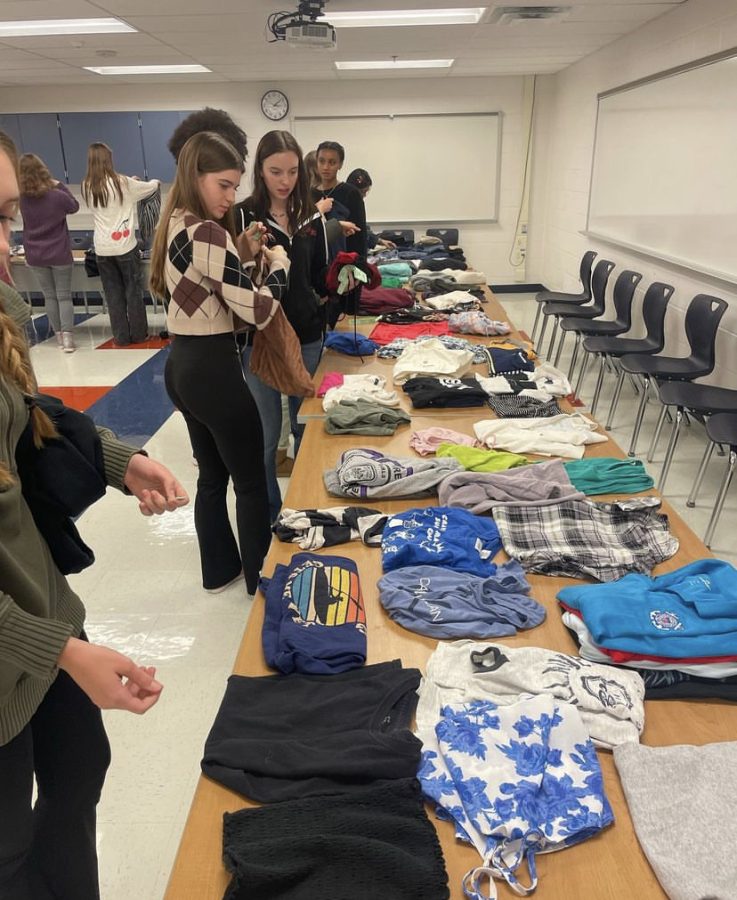Fast vs. sustainable: the pros and cons of haute couture
Photo courtesy of @wshs_environmentalclub on Instagram
Earlier this school year in December, students participated in the Environmental Clubs clothing swap where they were able to promote sustainability through donating clothes and reusing.
Vivienne Westwood was a fashion pioneer, making punk mainstream and working in environmental activism. After her passing last December, the extent to which Westwood has implemented the ideas of sustainability she preached and the future of fast fashion have come under scrutiny.
Ideally, to maintain sustainability, fashion designers produce fewer collections of higher quality, such as Peter Do. Do is a relatively new designer who launched his womenswear label in 2018. His work is sustainable in the sense that he focuses on assembling two collections a year, prioritizing quality over quantity. Like Do, Westwood was applauded for her turn toward sustainability. Although, the mark she has left on the fashion community does not overlook the fact that Westwood’s work is not as eco-friendly as it was made out to be.
“[Westwood] definitely plays it safe as an activist. She didn’t go against the Parisian fashion house tradition of testing on animals,” said senior and Fashion Club President Olivia Rummler. “While I appreciate her efforts towards stopping climate change, that’s about where her activism ends in my eyes. Protesting against fracking and the use of fossil fuels is definitely a good thing, but her label uses unnecessary fossil fuels in nearly every collection.”
Many of the negative environmental impacts of the fashion industry circle back to fast fashion, which has experienced a significant rise resulting in concern about its ethics. Fast fashion refers to cheap clothing that emulates trends seen in high fashion, made accessible to a wide range of people. Consumers are able to purchase clothing mimicking the latest microtrends at the height of their popularity both in-store and online.
“From my personal experience of thrifting, I’ve seen tons and tons of Shein items on the racks which can be really frustrating. I come to the thrift store to find clothes to give them another life, and a lot of the time, they are good quality and affordable,” said junior and Environmental Club member Evelyn Gazzola. “Giving clothes a new life means a lot to me. I personally even go to my family members asking to go through their old clothes they no longer wear because I find it so cool how much history and how many stories clothes can have.”
To maintain low prices, corporations often utilize cheap materials such as polyester that aren’t manufactured to be long-lasting. This results in the constant purchase and abandonment of rapidly manufactured products. The unwanted clothing then ends up in landfills, polluting the environment. Keeping up with trends additionally places immense pressure on underpaid garment workers to produce clothing at faster rates to keep up with demand.
“I think young designers should aim to do better than Westwood. Instead of preaching the end of unnecessary fossil fuels while using unnecessary fossil fuels, designers should just not use unnecessary fossil fuels,” said Rummler. “Given the ease of access to cotton, flax, bamboo, and other natural materials, there is no reason to use polyester or other plastic fibers. Thankfully, since the invention of nylon which is one of the most popular polyester fibers, plastic fibers have gone down to only making up around 12 percent of the market share.”
Generation Z is often seen as the biggest target of fast fashion due to being raised during the prime of social media and influencers. Advertisements, sponsorships, outfit of the day, and clothing haul posts are all ways in which fast fashion is promoted through social media for the youth to consume. Opposingly, social media is also used to raise awareness against the consumption of fast fashion, often by members of Gen Z. The Environmental Club participates in a clothing swap each year to promote the reuse of clothing.
“I participated in the clothing swap earlier this year and I definitely felt that it was useful. We were asked to bring in washed clothing that had been gently used so that they could be used in the swap,” said Gazzola. “A ticket system was also used where a certain amount of tickets would equate to a specific article of clothing. For example, I think t-shirts were one ticket while jackets were three. Overall I was glad that I was able to take some cool pieces home, and whatever was left ended up being donated.”






